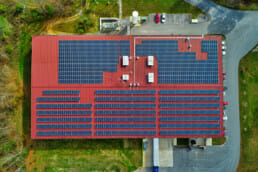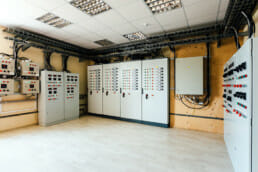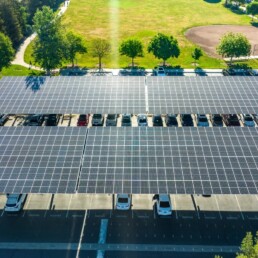
It’s no secret that California is struggling with wildfires, power shutoffs, and grid planning. What can Californians do to ensure resiliency for their homes, schools, cities, and businesses? Microgrids and more distributed energy resources (DERs) may be the best path.
The Status Quo Isn’t Working
Unpredictable Wildfires
For many Californians, wildfires are becoming more frequent occurrences. Dryer, hotter conditions and older electrical transmission lines are like tinder to a match – even the smallest spark can ignite a flame. Already this year, 6,787 wildfires have been recorded in the state, with billions of dollars spent on prevention, insurance and recovery.
Similar to hurricanes, wildfires are difficult to predict but planning and preparation can reduce the impact. California utilities have already taken measures into their own hands, with PG&E and SoCal Edison implementing widespread Public Safety Power Shutoffs (PSPS). These shutoffs have already affected over 2 million Californians this past October, including residents, businesses, schools, and more. Some were without power for hours and even days at a time.
High Cost of Electricity
The power shutoffs come at a time when electricity prices in California are some of the highest in the country. After the 2018 Paradise Fire, where hundreds of Northern Californians lost their homes, PG&E had to fork over billions in damages, eventually causing the utility to file for Chapter 11 Bankruptcy.
For California electricity customers, this means two things: supply instability and price uncertainty.
Supply instability is the result of wildfires and power shutoffs and can wreak havoc on businesses trying to maintain operations and provide services to customers. It can also mean that public services, such as traffic lights, are no longer available around the clock to serve local citizens.
Price uncertainty means that utility customers can no longer assume that the cost of electricity in the future will resemble the costs in the past.
Due to shifting time of use rates, fluctuating natural gas prices, and the increase of DERs, California retail electricity rates have been on the rise over the last two decades- and even more so in recent years. According to a 2018 analysis by Environmental Progress, California’s electricity prices rose three times more than they did in the rest of the United States between 2016 and 2017.
While it’s hard to predict future electricity rates as a whole, California shows little signs of decreasing. Utility rates for all three of California’s investor-owned utilities have risen slowly. As a result, commercial electricity rates are 75% more expensive than the U.S. average. With more unpredictability, it makes more sense for customers to consider solutions such as on-site generation and energy storage, to hedge against rising utility costs.
Power in Your Own Hands
In order to hedge against the unknown and potentially prepare for the worst, resiliency is on the minds of many. More Californians are looking into backup power options to keep their homes and businesses running when the grid is down. The good news is that there are several options available to help you put your electricity needs into your own hands.
What can you do?
Thanks to new technology and decreasing costs of renewable energy and energy storage, there are several options to ensure resiliency and hedge against rising electricity prices. Here is an overview of the technologies that you can leverage for more energy independence.
Compare Your Resiliency Options
Navigating these different options might seem overwhelming if you’re not privy to the various energy technologies available in the market today. The following table presents these options in more detail so that you can compare the best solution for your particular situation.
Gas or Diesel Generator
Pros:
- Reliable Power Production
- Low Upfront Cost
- Scalable to Suit Needs
Cons:
- Noise Pollution
- Carbon Emissions
- Fuel Cost and Availability Uncertainty
- No Demand and Energy Charge Reductions
- Higher Operating Cost
Battery Storage
Pros:
- Quiet Operation
- No Emissions
- Low Operating Costs
- Demand Charge Reductions
Cons:
- Limited Backup Period
- Higher Upfront Investment
Solar + Storage
Pros:
- Quiet Operation
- No Emissions
- Low Operating Costs
- Demand and Energy Charge Reductions
Cons:
- Limited Backup Period at Night
- Higher Upfront Investment
Microgrid: Generator + Solar + Storage
Pros:
- Low Operating Costs
- Demand and Energy Charge Reductions
- Long Term Backup and Resiliency
Cons:
- High Upfront Cost
- Fuel Cost and Availability Uncertainty
- Higher Operating Costs
Gas and Diesel Generators

Generators have been functioning as common backup power sources for decades. They are commonly found on the East Coast where annual hurricanes can cause power outages for days at a time.
Generators are available in two types: diesel- or natural gas-powered. Natural gas generators are commonly considered cleaner since they emit less CO2 than traditional diesel fuel generators. However, diesel generators are considered safer and more reliable since natural gas pipelines can erupt during events like earthquakes. However, both may be impacted by limited fuel supply during an emergency.
Generators can also contribute power to a microgrid, whereby your home or facility can operate independently of the electricity grid to power essential loads or appliances. They can also be paired with DERs (i.e. solar or energy storage) to help facilitate the transition periods between solar and battery storage systems.
It’s important to note that generators require an upfront investment and require constant fuel supply. The price of generators will vary based on their size and can be matched to your home or facility’s needs.
Pros:
- Low Upfront Investment
- Scalable to On-Site Needs
- Integration Option for Microgrids
- Non-Intermittent
Cons:
- Fuel Price Uncertainty
- Limited Fuel Supply During Emergencies
- Carbon Emissions
- Noise Pollution
- Higher Operating Expenses
The Verdict
Generators can be efficient backup power solutions from an upfront cost and reliability standpoint when paired with other solutions, but they will increase your carbon emissions and suffer from fuel price uncertainty over the long term.
Battery Storage

Battery storage systems are a great way to hedge against rising costs and can sometimes serve as a backup power source when the utility grid is down.
One major benefit of battery storage is that it leverages advanced software to reduce facility demand charges by leveling out spikes during peak periods. This is possible by automated charging during low price periods and discharging during high ones, resulting in a lower electricity bill. Demand charge reduction is only possible when the utility grid is active although this can help offset any cost that you would otherwise pay for backup power.
When the utility grid is down, battery storage can also provide reliable backup power to sustain your operations. A typical standalone battery storage system may provide about two to four hours of operation, depending on its size. It is important to note that a battery storage system would need “islanding” or “microgrid” capabilities in order to operate in the event of a power shutoff. This means that you would be able to run your own power independently of the grid, when necessary.
Pros:
- Demand Charge Reduction Savings
- No Carbon Emissions
- Advanced Software and Management
- Some Backup Capability
- Low Operating Expenses and Ongoing Management Cost
Cons:
- Limited Backup Period (hours, not days)
- Higher Upfront Investment (unless procured through shared savings model)
The Verdict
Battery storage systems can provide immense savings through demand charge management and peak power reductions, and advanced software can easily adjust to changing utility tariffs to provide more savings. Backup power can be available for several hours when the grid goes down but you’ll need something else if you need power for days at a time.
Solar + Storage

During utility grid operation, you can still reap the benefits of demand charge reduction from the battery storage system while on-site solar can further reduce expenses through a lower electricity rate. Solar energy would charge the battery when there is excess power and the battery can then discharge this electricity when costs from the grid are high.
During a utility shutoff, a solar plus battery storage system can also operate independently from the utility grid when configured for this purpose. The combined system would then provide power to critical loads when needed and charge the system during the day. Simply put, it’s like having solar power available when you need it rather than when the sun is shining. Similar to a standalone battery storage system, the system would need “islanding” or “microgrid” capabilities in order to operate in the event of a power shutoff.
Pros:
- Demand Charge Reduction Savings
- Lower Electricity Cost with Solar (with Power Purchase Agreement)
- Quiet Operation
- No Carbon Emissions
- Advanced Software and Management
- Backup Capability
- Low Operating Expenses and Ongoing Management Cost
Cons:
- Limited Backup Period (hours, not days)
- Higher Upfront Investment (unless procured through shared savings model)
The Verdict
Solar plus storage can provide a unique combination of demand charge reduction, reduced energy costs from solar, and backup power. Where the sun is reliable (i.e. California), this might be the best option to avoid a fossil fuel alternative.
Microgrids: Generator + Battery Storage + Solar

The importance of battery backup and resiliency for critical facilities (i.e. military bases and hospitals) sparked another option called a “microgrid”. These microgrids are now gaining in popularity for businesses and public sector infrastructure as decision makers evaluate the importance of resiliency and cost predictability.
What exactly is a microgrid?
Technically speaking, a microgrid is exactly what it sounds like: a miniature electrical grid that supplies power to a building or a community. A microgrid can be fed by any type or number of electrical sources including solar panels, wind turbines, battery storage systems, and diesel or natural gas generators.
What makes microgrids unique in that they have the capability to “island” themselves off from a larger utility grid, meaning that they can function independently in the event of a power blackout. Depending on the electricity source in use and whether there is a storage component, microgrids can supply power temporarily or permanently.
Microgrids are seen more frequently in rural areas of developing countries that do not have access to a centralized electrical grid or for critical facilities that must operate in rare power outages. Most microgrids in modern countries are fed by diesel generators, but newer microgrids are incorporating more DERs such as solar and battery storage systems. As of 2017 there are nearly 2,000 microgrids in operation in the U.S., and that number continues to grow.
Pros:
- Benefits of Solar and Battery Storage
- Option for Permanent Backup Power
- Potential for No Carbon Emissions
- Advanced Software and Management
Cons:
- High Upfront Investment
- Advanced Engineering and Permitting Required
- Fuel Price Uncertainty
- Limited Fuel Supply During Emergencies
- Carbon Emissions
- Noise Pollution
The Verdict
If you have a lot of electricity load and the ability to get economies of scale through combined electricity supply, this could be a good option. Moreover, a microgrid might be a necessity if you have critical loads and don’t want to rely entirely on fossil fuels for power supply during a grid outage.
Customized Advice for Your Facility
Does it truly make sense to invest or choose backup power and redundancy? Is a microgrid a viable, cost-effective solution? What incentives are available in my area?
There is no ‘right answer’ or singular approach to resiliency. Every facility’s situation is unique, and the right solution will depend on your load profile, overall consumption, and physical space. While it might make sense for a larger entity to incorporate multiple resources on-site, that same approach may not be possible for a smaller entity with space constraints.
If you are looking to build a resiliency plan for your school, municipality, or business and aren’t sure which approach might be best, ForeFront Power’s team of energy experts can walk you through the various options available to you.
The time is now to start planning for the next wildfire and power shutoff season. You shouldn’t have to worry about whether your students will be able to come to school or if your business will be open for customers.

ForeFront News
November 25, 2024
Agrivoltaics in Ames: Solar Energy Meets Sheep Grazing
November 18, 2024
Penske Truck Leasing Lights Up New Solar-Powered Facility Initiative
October 23, 2024
Building Solar and Minds with Bakersfield College
Interested in learning more?
We would love to discuss how our solutions might be a fit for your organization. Contact one of our solar, storage, or e-mobility experts today:







